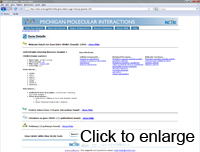- Search NCIBI Data
(e.g. diabetes, csf1r) - Login

 Michigan Molecular Interactions (MiMI)
Michigan Molecular Interactions (MiMI)
Find protein interactions, pathways, compounds, literature, and genes merged from multiple sources.
Michigan Molecular Interactions (MiMI) allows you to easily explore an extensive database of protein interactions, pathways and genes. The data in MiMI comes from multiple external and internal data sources including DIP, BIND and NCIBI's NLP literature mining efforts. MiMI employs deep merging techniques to identify entities that are the same across data sources. Once identity has been determined, the entries are merged and their provenance is recorded. Since data sets often contain contradictory or overlapping information, the deep-merging corrects for duplications, synonyms, and redundant interactions across identifiers. The deep-merging provenance model tracks where each piece of data came from and what processes have been performed upon it. The integrated data reside in a relational database.
Through the MimiWeb interface, you can set query conditions such as species or sources, perform free text searches, and/or upload large sets of gene symbols or geneIds (see the help page for details). MimiWeb displays results in way that allows for further exploration and vetting. You can choose to sort and group items of interest, easily drill down to details, and easily link out to external knowledge sources. New with V3.0, you can view positions of gene symbol tags within PubMed abstracts (see "document details" from gene detail page or interaction detail page, or from the document list for a gene or interaction). MimiWeb is integrated with the NCIBI Suite of Tools, allowing you to easily carry requests from one tool to the next. You can display and manipulate protein/gene interactions and associated biological attributes in networks visualized through the MiMI Plugin for Cytoscape graphing tool, view associated Medical Subject Headings in Gene2MeSH, easily browse the network of interactions in NetBrowser, and perform subgraph matches by inputting selected sub-graphs to SAGA.
MiMI is useful for knowledge production and discovery. With it, you can easily explore comprehensive biological relationships associated with candidate genes; gather and analyze data in one place, view summaries and citations on the proteins/genes and protein interactions of interest, or easily link out to other specialized tools. The MiMI database and MimiWeb interface are important entry points into the NCIBI Suite of Tools.
MiMI also has a programmatic interface that allows you to incorporate MiMI in a data processing pipeline.

 NCIBI on Facebook
NCIBI on Facebook NCIBI RSS Feed
NCIBI RSS Feed

